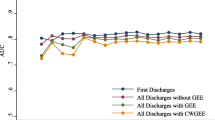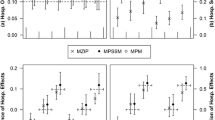Abstract
Motivated by the national evaluation of readmission rates among kidney dialysis facilities in the United States, we evaluate the impact of including discharging hospitals on the estimation of facility-level standardized readmission ratios (SRRs). The estimation of SRRs consists of two steps. First, we model the dependence of readmission events on facilities and patient-level characteristics, with or without an adjustment for discharging hospitals. Second, using results from the models, standardization is achieved by computing the ratio of the number of observed events to the number of expected events assuming a population norm and given the case-mix in that facility. A challenging aspect of our motivating example is that the number of parameters is very large and estimation of high-dimensional parameters is troublesome. To solve this problem, we propose a structured Newton-Raphson algorithm for a logistic fixed effects model and an approximate EM algorithm for the logistic mixed effects model. We consider a re-sampling and simulation technique to obtain p-values for the proposed measures. Finally, our method of identifying outlier facilities involves converting the observed p-values to Z-statistics and using the empirical null distribution, which accounts for overdispersion in the data. The finite-sample properties of proposed measures are examined through simulation studies. The methods developed are applied to national dialysis data. It is our great pleasure to present this paper in honor of Ross Prentice, who has been instrumental in the development of modern methods of modeling and analyzing life history and failure time data, and in the inventive applications of these methods to important national data problem.





Similar content being viewed by others
References
Breslow NE, Clayton DG (1993) Approximate inference in generalized linear mixed models. J Am Stat Assoc 88:9–25
Breslow NE, Lin X (1995) Bias correction in generalized linear mixed models with a single component of dispersion. Biometrika 82:81–91
Dempster AP, Laird NM, Rubin DB (1977) Maximum likelihood from incomplete data via the EM algorithm. J Royal Stat Soc B 39:1–38
Efron B (2004) Large-scale simultaneous hypothesis testing: the choice of a null hypotheses. J Am Stat Assoc 99:96–104
Efron B (2007) Size, power and false discovery rates. Ann Stat 35:1351–1377
Goldfield NI, McCullough EC, Hughes JS, Tang AM, Eastman B, Rawlins LK, Averill RF (2008) Identifying potentially preventable readmissions. Health Care Financing Rev 30:75–91
Hirth RA, Turenne MN, Wheeler J, Pan Q, Ma Y, Messana JM (2009) Provider monitoring and pay-for- performance when multiple providers affect outcomes: an application to renal dialysis. Health Serv Res 44(5):1585–1602
Hirth RA, Turenne MN, Wheeler J, Ma Y, Messana JM (2010) Do resource utilization and clinical measures still vary across dialysis chains after controlling for the local practices of facilities and physicians? Medical Care 48(8):726–732
Horwitz L, Partovain C, Lin ZQ, Herrin J, Grady J, Conover M, Montague J, Dillaway C, Bartcazk K, Suter L, Ross J, Bernheim S, Krumholz H, Drye E (2011) Hospital-wide all-cause risk-standardized readmission measure: measure methodology report. Yale New Heaven health services corporation/center for outcomes research and evaluation (YNHHSC/CORE). https://www.cms.gov/Medicare/Quality-Initiatives-Patient-Assessment-Instruments/MMS/download/MMSHospital-WideAll-ConditionReadmissionRate.pdf. Accessed 27 March 2013
Kalbfleisch JD, Wolfe RA (2013) On monitoring outcomes of medical providers. Stat Biosciences (in press)
Lange K (1999) Numerical analysis for statisticians. Springer, New York
Lin X, Breslow NE (1996) Bias correction in generalized linear mixed models with multiple component of dispersion. J Am Stat Assoc 91:1007–1016
Liu D, Schaubel DE, Kalbfleisch JD (2012) Computationally efficient marginal models for clustered recurrent event data. Biometrics 68:637–647
Spiegelhalter D, Sherlaw-Johnson C, Bardsley M, Blunt I, Wood C, Grigg O (2012) Statistical methods for healthcare regulation: rating, screening and surveilliance. J Royal Stat Soc A 175(1):1–47
Turenne MN, Hirth RA, Pan Q, Wolfe RA, Messana JM, Wheeler J (2008) Using knowledge of multiple levels of variation in care to target performance incentives to providers. Medical Care 46(2):120–126
Turenne MN, Hirth RA, Messana JM, Turner JS, Sleeman KK, Wheeler J (2010a) When payment systems collide: the effect of hospitalization on anemia in renal dialysis patients. Medical Care 48(4):296–305
Turenne M, Hunter S, Wolfe R, Shearon T, Pearson J, Kalbfleisch J, Dahlerus C, Wheeler J (2010b) 30-day hospital readmission among dialysis patients: influence of dialysis facilities versus hospitals. Annual Meeting of the American Society of Nephrology, Denver
US Renal Data System (USRDS) (2012) Annual data report: atlas of chronic kidney disease and end-stage renal disease in the United States, National Institutes of Health, National Institute of Diabetes and Digestive and Kidney Diseases, Bethesda, MD. http://www.usrds.org/2012/slides/indiv/v1index.html Accessed 27 March 2013
Zeger SL, Karim R (1991) Generalized linear models with random effects: a Gibbs sampling approach. J Am Stat Assoc 86:79–86
Acknowledgments
The authors would like to thank Dr. Marc Turenne, Professor John Wheeler, Professor Joseph Messana, Ms. Deanna Chyn, Ms. Tempie Shearon and Ms. Valarie Ashby for helpful discussion and comments. We also acknowledge with thanks the comments from the Editors and referees on this paper, which helped to improve the presentation. This work was supported in part by a contract from the Centers for Medicare and Medicaid Services (CMS), although the opinions presented here are not necessarily those of the CMS.
Author information
Authors and Affiliations
Corresponding author
Appendices
Appendices
1.1 Appendix 1: model fitting algorithm of the fixed-effects model
-
(i)
Set initial values for \({\varvec{\beta }^{(0)}}\) and \(\gamma _i^{(0)}\) and \(\ell =0\)
-
(ii)
For fixed \(\varvec{\beta }={\varvec{\beta }}^{(\ell )}\), update \(\gamma _i\) using a one-step Newton-Raphson iteration as
$$\begin{aligned} \gamma _i^{(\ell +1)} = \gamma _i^{(\ell )} + {I_{i}^{(\ell )}}^{-1} U_{i}^{(\ell )}, \end{aligned}$$where
$$\begin{aligned} U_{i}^{(\ell )}&:= \frac{\partial }{\partial \gamma _i} \log L(\gamma _i,\varvec{\beta }^{(\ell )})\bigg |_{\gamma _i = \gamma _i^{(\ell )}} =\sum _{k=1}^{n_i} [ Y_{ik} - p_{ik}^{(\ell )}], \\ I_{i}^{(\ell )}&:= -\frac{\partial ^2}{\partial \gamma _i^2} \log L(\gamma _i,\varvec{\beta }^{(\ell )})\bigg |_{\gamma _i = \gamma _i^{(\ell )}}=\sum _{k=1}^{n_i} p_{ik}^{(\ell )} [1-p_{ik}^{(\ell )}], \end{aligned}$$with
$$\begin{aligned} p_{ik}^{(\ell )} := p_{ik}(\gamma _i^{(\ell )},\varvec{\beta }^{(\ell )}). \end{aligned}$$ -
(iii)
Now update \(\varvec{\beta }\) by carrying out one step of the Newton-Raphson iteration
$$\begin{aligned} \varvec{\beta }^{(\ell +1)} := \varvec{\beta }^{(\ell )} + {I_{\varvec{\beta }}^{(\ell )}}^{-1} U_{\varvec{\beta }}^{(\ell )}, \end{aligned}$$where
$$\begin{aligned} U_{\varvec{\beta }}^{(\ell )}&:= \frac{\partial }{\partial \varvec{\beta }} \log L(\gamma ^{(\ell +1)},\varvec{\beta })\bigg |_{\varvec{\beta }= \varvec{\beta }^{(\ell )}} \\&= \sum _{i=1}^{F} \sum _{k=1}^{n_i} \{Y_{ik} - p_{ik}^{(\ell )*} \} \mathbf Z _{ik}, \\ I_{\varvec{\beta }}^{(\ell )}&:= -\frac{\partial ^2}{\partial \beta \partial \beta ^T} \log L(\gamma ^{(\ell +1)},\varvec{\beta })\bigg |_{\varvec{\beta }= \varvec{\beta }^{(\ell )}} \\&= \sum _{i=1}^{F} \sum _{k=1}^{n_i} p_{ij}^{(\ell )*} \{1-p_{ik}^{(\ell )*}\} \mathbf Z _{ik}\mathbf Z _{ik}^T, \end{aligned}$$with
$$\begin{aligned} p_{ik}^{(\ell )*} := p_{ik}(\gamma _i^{(\ell +1)},\varvec{\beta }^{(\ell )}). \end{aligned}$$ -
(iv)
If \(\max \Vert p_{ik}^{(\ell +1)*} - p_{ik}^{(\ell )*} \Vert > 10^{-6}\), set \(\ell =\ell +1\) and go back to step (i).
1.2 Appendix 2: Newton-Raphson algorithm for the mixed-effects model
The \(\gamma _i\) is updated as
where
Similarly, \(\varvec{\beta }\) is updated as
where
The \(\varvec{\gamma }\) and \(\varvec{\beta }\) are then repeatedly updated until they converge.
Rights and permissions
About this article
Cite this article
He, K., Kalbfleisch, J.D., Li, Y. et al. Evaluating hospital readmission rates in dialysis facilities; adjusting for hospital effects. Lifetime Data Anal 19, 490–512 (2013). https://doi.org/10.1007/s10985-013-9264-6
Received:
Accepted:
Published:
Issue Date:
DOI: https://doi.org/10.1007/s10985-013-9264-6




